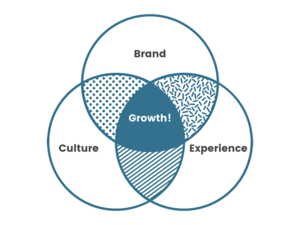Patient Experience + Brand + Culture = Growth
// By Sally Mildren //
 For patient experience to be successful, it must be woven into the culture, expressed through your brand and marketing, and demonstrated first and foremost to your employees.
For patient experience to be successful, it must be woven into the culture, expressed through your brand and marketing, and demonstrated first and foremost to your employees.
Truly exceptional patient experience programs thrive at the intersection of culture, engagement, and experience. This has played out in study after study by Monigle, PwC, McKinsey, Medallia, and many others. Good experience equals growth — in revenue, reputation, loyalty, satisfaction, and employee engagement.
Yet inconsistent consumer experiences, misaligned resources, and inability to access information continue to create a gap between employees of health care organizations and the patients they serve.
The problem is rarely a lack of knowing you need change, but instead frayed bandwidth, competing priorities, lack of dedicated resources, and a squishy commitment to truly address the organizational changes that are tightly tied to great patient experience.
But let’s be real. After these last two pandemic-dominated years, our focus has got to be on getting people vaccinated, addressing staff burnout, getting elective procedures back, and returning to our new state of normal. Can’t patient experience wait?
Data supports NOT waiting. According to Forrester, experience-led companies have 1.7x better retention of customers, 1.5x better employee engagement, 1.9x higher return on spend, and 1.6x better brand awareness. Not to mention that for every +1 percent increase in customer satisfaction, the resulting millions in revenue increases are trackable across all industries.
Let’s take a look at what it takes to build an extraordinary patient experience program.
Patient Experience Must Be a Cultural Commitment
 What does it look like to culturally become an experience-led organization? It means from the board members down, the commitment to patient experience is reflected in your purpose and vision, operational planning, budgeting, and strategy.
What does it look like to culturally become an experience-led organization? It means from the board members down, the commitment to patient experience is reflected in your purpose and vision, operational planning, budgeting, and strategy.
Experience will be infused throughout your organization so that creating a patient-centered care mission becomes your ethos. It means you put your money where your mouth is and staff, resources, and training will be aligned to the promises you make within your culture.
Without a top-down commitment to transform your organization’s culture into an experience-led business, you will not successfully implement, gain buy-in, or sustain the progress of your work.
Patient Experience Must Be Aligned to Employee Engagement
As surveys show time and time again, money can’t buy you engagement from your staff. Another email newsletter, better snacks, or more cheerleading at a town hall will not help. Instead, an authentic and demonstrable commitment to being experience-led will be expressed first to your team.
Of course, happier employees will provide better experiences, but recent data from a 2021 study by McKinsey & Co. showed that employees who felt their work was aligned to purpose were 6.5x more likely to report higher resilience, 4x more likely to report better health, and 6x more likely to want to stay with the company. That is music to concerned health care HR leaders’ ears!
When we can translate our commitment to being experience-led and doing what is right for the patient into our culture, purpose, and activities, that alignment will fuel healthier and more engaged staff. Another McKinsey health care workforce study at the end of 2020 found that caregivers are looking for acknowledgment, appreciation, and to be heard, especially following the challenges of the past couple of years.
So what does it look like to be experience-led in employee engagement? It means that:
- Performance measures, training, and staffing are in alignment with the commitment to take care of patients and staff.
- Staff has opportunities to provide feedback, and the organization is open to continuous improvement and growth.
- There are adequate resources and training, and communication is open and honest.
- All individuals understand their vital role and connection to the overall purpose of the organization and in the delivery of exceptional service to patients.
Patient Experience Must Be Expressed in Your Organizational Branding
Your organization’s commitment to being experience-led can’t be a conversation for internal meetings only. It must become infused throughout your work — from mission and purpose to advertising campaigns to member and patient communications.
Nearly 50 percent of consumers feel that consistency in information across all channels is essential to a great customer experience. And that perception of their experience includes the collective whole of every interaction, communication, and touchpoint.
Marketing plays an important role in weaving these messages throughout the organization, in branding, signage, newsletters, communications, websites, intranets, and more. The brand promise and story must reflect and amplify the organizational commitment to being an experience-led organization.
To build an extraordinary, sustainable patient experience program is not a quick fix. For patient experience to be successful, it must be woven into the culture, expressed through your brand and marketing, and demonstrated first and foremost to your employees.
The real question that remains is: Can you afford to wait on patient experience?
Sally Mildren is CEO and managing partner of Boss Lady Consulting, LLC in Santa Fe, New Mexico. The agency helps health care organizations identify, prioritize, and operationalize growth opportunities for customer experience, branding, culture, and engagement. Connect @bossladyconsult on LinkedIn, Facebook, and Twitter.
